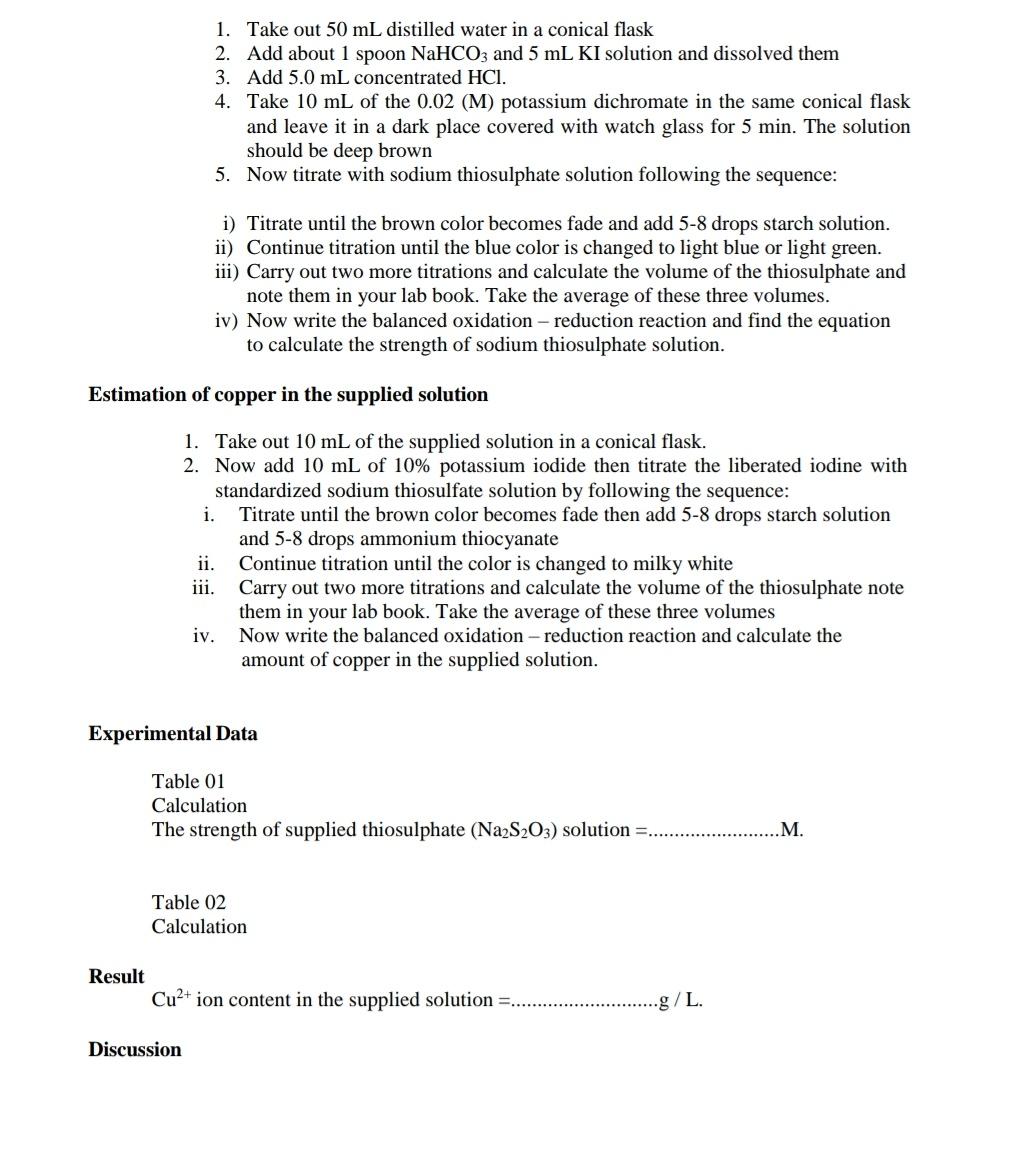Answered step by step
Verified Expert Solution
Question
1 Approved Answer
Name of the Experiment Estimation of copper in the supplied solution using standardized sodium thiosulphate solution. Theory When KI is added to a solution


Name of the Experiment Estimation of copper in the supplied solution using standardized sodium thiosulphate solution. Theory When KI is added to a solution of copper sulfate, white cuprous iodide (Cu12) is precipitated and an equivalent amount of iodine is liberated. This free iodine is titrated against standard solution of sodium thiosulphate using starch as an indicator. As soon as all the liberated iodine has been reduced to iodide (Nal), the blue color of starch-iodine complex will disappear and the color of precipitation in conical flask will be white due to the formation of cuprous iodide. This indicates the end point. 2CuSO4 + 4KI = CuI2 () (white ppt.) + 2KSO4 + 12 2Na2S2O3 + 12 = Na2S4O6 + 2Nal Therefore, 2 CuSO4 = I2 = 2Na2SO3 1 mole CuSO4= 1 mole Na2S2O3 So, 1000mL of 1M Na2S2O3 solution = 63.54 g of copper Procedure In order to estimate the copper contained by the iodometric method at first we shall have to determine the strength of sodium thiosulphate solution. Then by using the standardized sodium thiosulphate solution we will determine the amount of copper by titration. Standardization of sodium thiosulphate solution a. Preparation of 0.02 (M) K2Cr2O7 solution Make a 100 mL of this solution by dissolving the calculated amount of potassium dichromate in 100 mL of distilled water in a 100 mL volumetric flask. Use electronic balance very carefully to measure the amount of potassium dichromate. b. Standardization of sodium thiosulphate using standard potassium dichromate 1. Take out 50 mL distilled water in a conical flask 2. Add about 1 spoon NaHCO3 and 5 mL KI solution and dissolved them 3. Add 5.0 mL concentrated HCI. 4. Take 10 mL of the 0.02 (M) potassium dichromate in the same conical flask and leave it in a dark place covered with watch glass for 5 min. The solution should be deep brown 5. Now titrate with sodium thiosulphate solution following the sequence: i) Titrate until the brown color becomes fade and add 5-8 drops starch solution. ii) Continue titration until the blue color is changed to light blue or light green. iii) Carry out two more titrations and calculate the volume of the thiosulphate and note them in your lab book. Take the average of these three volumes. iv) Now write the balanced oxidation - reduction reaction and find the equation to calculate the strength of sodium thiosulphate solution. 1. Take out 10 mL of the supplied solution in a conical flask. 2. Now add 10 mL of 10% potassium iodide then titrate the liberated iodine with standardized sodium thiosulfate solution by following the sequence: i. Titrate until the brown color becomes fade then add 5-8 drops starch solution and 5-8 drops ammonium thiocyanate ii. Continue titration until the color is changed to milky white iii. Carry out two more titrations and calculate the volume of the thiosulphate note them in your lab book. Take the average of these three volumes iv. Now write the balanced oxidation - reduction reaction and calculate the amount of copper in the supplied solution. Experimental Data Table 01 Calculation The strength of supplied thiosulphate (Na2S2O3) solution .M. Table 02 Calculation Cu+ ion content in the supplied solution Estimation of copper in the supplied solution Result Discussion g/L.
Step by Step Solution
★★★★★
3.50 Rating (180 Votes )
There are 3 Steps involved in it
Step: 1
In acid solution practically all oxidizing agents will oxidize iodide ion to iodine quantitatively T...
Get Instant Access to Expert-Tailored Solutions
See step-by-step solutions with expert insights and AI powered tools for academic success
Step: 2

Step: 3

Ace Your Homework with AI
Get the answers you need in no time with our AI-driven, step-by-step assistance
Get Started


